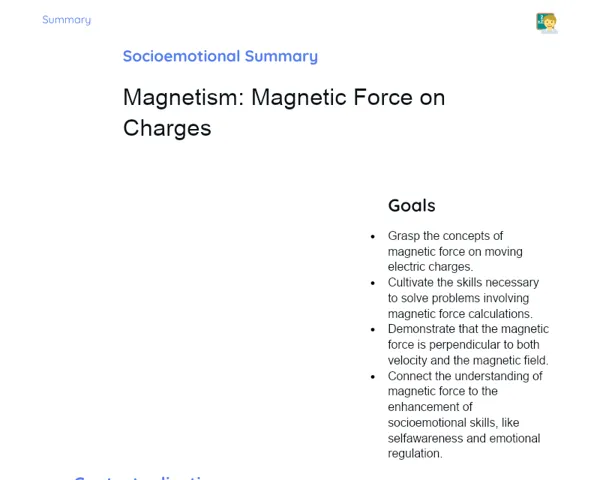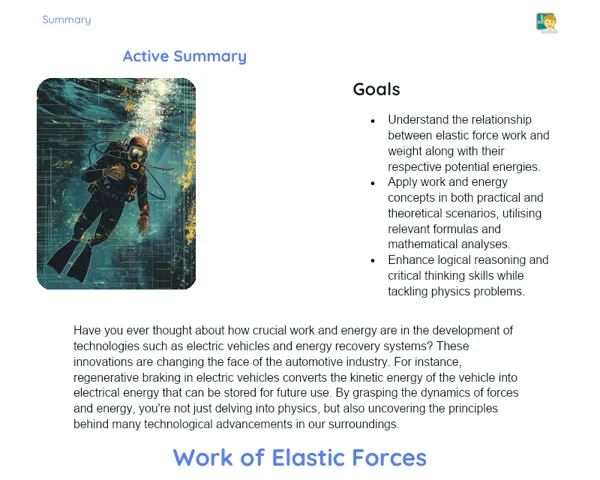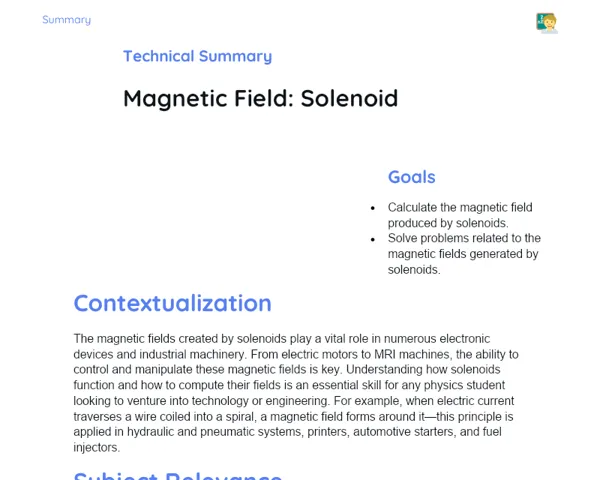Socioemotional Summary Conclusion
Goals
1. Develop a clear understanding of escape velocity and its significance in the realm of gravity.
2. Enhance your skills to calculate the escape velocity for various planets and celestial bodies.
3. Cultivate self-awareness and maintain calm while tackling challenging problem-solving tasks.
Contextualization
Did you know that for a rocket to lift off from Earth, it must achieve a certain speed to break free from Earth’s gravity? This required speed, known as escape velocity, is a fundamental piece of every space mission. In this summary, we will delve into the fascinating subject of gravitation, learn how to solve real-life problems, and at the same time, develop important socioemotional skills to manage complex challenges.
Exercising Your Knowledge
Escape Velocity
Escape velocity is the minimum speed an object must attain to break free from the gravitational pull of a celestial body, such as a planet or moon, without needing any extra thrust. This idea is essential not only for understanding how rockets leave Earth but also for exploring space in general.
-
🎯 Definition: The minimum speed needed for an object to overcome the gravitational pull of a celestial body.
-
🚀 Importance: Critical for space missions and exploration, as seen in our own ISRO projects.
-
📏 Formula: v = √(2GM/R), where 'G' is the gravitational constant, 'M' is the mass of the celestial body, and 'R' is its radius.
Gravitation
Gravitation, or gravity, is the force that attracts two masses towards one another. It explains everyday phenomena, like why an apple falls from a tree, and also governs the orbits of planets around the Sun. Recognised as one of the four fundamental forces, it plays a pivotal role in our understanding of the universe.
-
🌌 Definition: A force that pulls two masses towards each other.
-
🌍 Impact on Earth: Responsible for everyday events such as falling objects and the orbit of our planet.
-
🔭 Universal Importance: Essential for the formation and maintenance of stars, planets, and galaxies.
Escape Velocity Equation
The equation for escape velocity, v = √(2GM/R), is derived from balancing kinetic energy with gravitational potential energy. This formula allows us to compute the speed required for an object to overcome the gravitational grip of any celestial body, be it a planet, a moon, or even a star.
-
🧮 Formula: v = √(2GM/R), where 'v' stands for escape velocity, 'G' is the gravitational constant, 'M' is the mass of the body, and 'R' is its radius.
-
🔍 Derivation: Comes from combining the concepts of kinetic energy and gravitational potential energy.
-
🌠 Practical Applications: Applies directly in calculating the speeds needed for rockets in space missions.
Key Terms
-
Escape Velocity: The minimum speed needed for an object to overcome a celestial body’s gravity.
-
Gravitation: The force that draws two masses towards each other.
-
Gravitational Constant (G): A key value that quantifies the strength of gravitational attraction between objects.
-
Mass (M): The amount of matter in an object, which directly influences the force of gravity.
-
Radius (R): The distance from the center of a celestial body to its surface, used in escape velocity computations.
For Reflection
-
How did you feel when calculating escape velocity? What emotions came up when you first encountered this challenge?
-
In what ways does understanding gravitation and escape velocity shape your view of space exploration and our place in the universe?
-
What strategies can you adopt to manage feelings like frustration or anxiety when dealing with complex problems, and how might these strategies benefit you in other areas of life?
Important Conclusions
-
Escape velocity is the minimum speed required for an object to break free from a celestial body’s gravitational pull.
-
A solid understanding of gravitation helps explain phenomena ranging from falling objects here on Earth to the orbits of planets in space.
-
The escape velocity equation, which combines kinetic and gravitational potential energy, is indispensable for calculating the speeds needed in rocket launches.
-
Tackling challenging problems like escape velocity calculations not only sharpens your analytical skills but also enhances your socioemotional abilities like self-awareness and self-control.
Impacts on Society
The idea of escape velocity has a significant impact on our society. For instance, launching satellites and space probes—such as those managed by ISRO—relies on this very formula. This understanding helps us capture amazing images of the universe, forecast weather more accurately, and even monitor environmental changes like deforestation in our country. Moreover, contemplating the enormity and beauty of the cosmos instills a sense of curiosity and wonder, pushing us to seek more knowledge about physics and our world. Recognising the intricacy of the universe can also foster greater empathy and respect towards our planet and fellow human beings, encouraging more thoughtful and sustainable actions in our daily lives.
Dealing with Emotions
To further boost your emotional intelligence, try this exercise at home: Think of a recent challenge, such as when you calculated escape velocity during class. Take a few moments to acknowledge the feelings that arose, be it frustration, curiosity, or anxiety, and try to identify their causes. Name these emotions clearly and consider discussing them with a friend or jotting them down in a diary. Then, reflect on strategies that could help you manage these emotions in the future, such as taking short breaks, practicing deep breathing, or seeking assistance when needed. This exercise can support you not just in physics, but in various aspects of life.
Study Tips
-
Revisit the main concepts of gravitation and escape velocity using diagrams and practical examples to visualise the formulas effectively.
-
Practice solving problems starting with simpler ones and gradually move to more complex scenarios to build confidence and deepen your understanding.
-
Participate in study groups or online forums where you can discuss queries and share insights with fellow students, making learning a more interactive experience.



